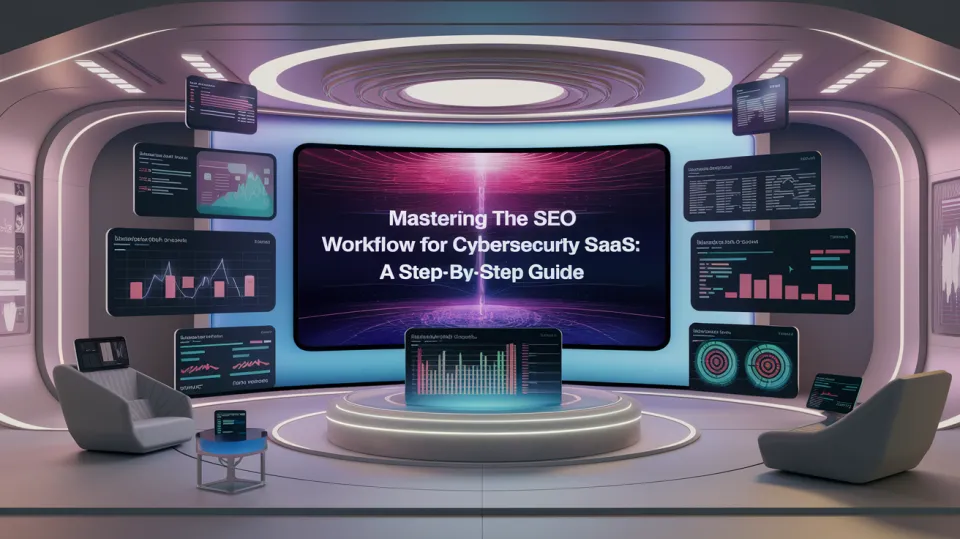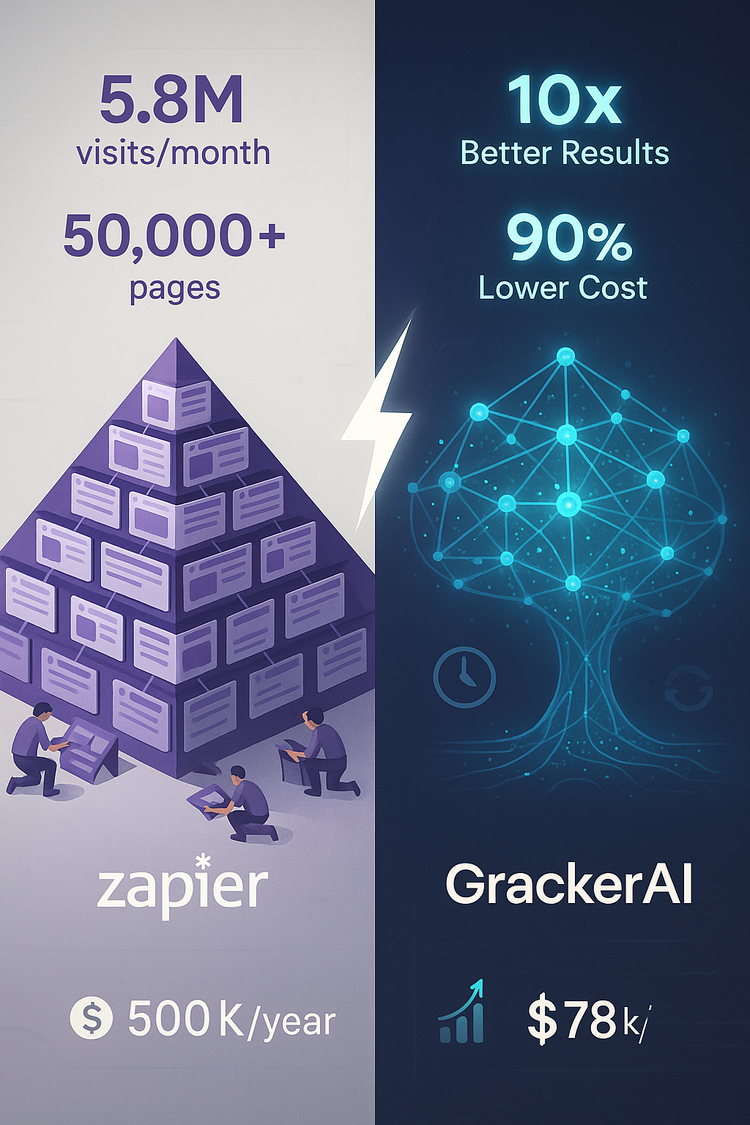Mastering the SEO Workflow for Cybersecurity SaaS: A Step-by-Step Guide

In today's digital landscape, where cyber threats are ever-evolving and businesses are increasingly aware of their vulnerability, Cybersecurity SaaS companies have a crucial role to play. However, having a great product isn't enough – you need to ensure that your target audience can find you amidst the sea of competitors. This is where Search Engine Optimization (SEO) becomes your secret weapon.
I. Introduction
In the competitive world of Cybersecurity SaaS, visibility is key. A robust SEO strategy can be the difference between obscurity and industry leadership. By implementing effective SEO practices, you can:
- Increase brand awareness by appearing at the top of search results for relevant queries
- Generate high-quality leads by attracting users actively searching for cybersecurity solutions
- Drive sales by positioning your product as the go-to solution for specific cybersecurity challenges
This comprehensive guide will walk you through a proven SEO workflow tailored for the unique challenges of Cybersecurity SaaS. By following these steps, you'll be well on your way to boosting your organic traffic and attracting qualified leads.
II. Understanding Your Target Audience
Before diving into keyword research and content creation, it's crucial to have a clear understanding of who your ideal customers (ICP) are. This knowledge will inform every aspect of your SEO strategy.
Identify Key Demographics and Pain Points
- Company size: Are you targeting small businesses, enterprises, or both?
- Industry verticals: Which sectors are most in need of your cybersecurity solution?
- Decision-makers: Are you targeting CISOs, IT managers, or other roles?
- Common challenges: What cybersecurity issues do your potential customers face?
Research Online Behavior and Search Patterns
- Analyze industry forums and social media discussions to understand common questions and concerns
- Use tools like Google Trends to identify popular search terms in the cybersecurity space
- Examine your competitors' content to see what topics resonate with your target audience
Create Detailed Buyer Personas
Develop 2-3 detailed buyer personas that represent your ideal customers. Include information such as:
- Job title and responsibilities
- Key performance indicators (KPIs)
- Challenges and pain points
- Preferred information sources
- Decision-making process
These personas will guide your content creation and keyword research, ensuring that your SEO efforts are always aligned with your target audience's needs and preferences.
III. Keyword Research and Strategy
With a clear understanding of your target audience, it's time to dive into keyword research – the foundation of any successful SEO strategy.
The Keyword Research Process for Cybersecurity SaaS
- Start with seed keywords: Begin with broad terms related to your product, such as "cybersecurity software," "threat detection," or "network security."
- Expand your list: Use keyword research tools to find related terms and long-tail keywords. Some popular tools include:
- Google Keyword Planner
- SEMrush
- Ahrefs
- Moz Keyword Explorer
- Focus on long-tail keywords: These are longer, more specific phrases that often have lower search volume but higher conversion potential. For example, "cloud-based endpoint detection and response software for small businesses."
- Analyze search intent: Ensure that the keywords you target align with your content and offerings. For instance, "how to prevent ransomware attacks" suggests informational intent, while "buy antivirus software" indicates commercial intent.
- Consider industry-specific terminology: Don't forget to include technical terms and acronyms commonly used in the cybersecurity field, such as "SIEM," "zero-day vulnerabilities," or "multi-factor authentication."
Create a Keyword Map
Organize your keywords into a comprehensive keyword map. This document should include:
- Target keyword
- Search volume
- Keyword difficulty
- Search intent
- Target page on your website
- Current ranking (if any)
This map will help you track your progress and ensure that each important keyword is being targeted appropriately across your site.
IV. On-Page Optimization
Once you have your keyword strategy in place, it's time to optimize your website's content to improve its search engine visibility.
Craft SEO-Friendly Titles and Meta Descriptions
- Title tags: Include your target keyword near the beginning of the title. Keep titles under 60 characters to avoid truncation in search results.
Example: "Cloud-Based SIEM Solutions | Real-Time Threat Detection | CyberGuard" - Meta descriptions: Write compelling, informative descriptions that include your target keyword and a clear call-to-action. Aim for 150-160 characters.
Example: "Protect your network with CyberGuard's cloud-based SIEM solution. Real-time threat detection and response. Start your free trial today!"
Optimize Content with Relevant Keywords
- Use your target keyword in the first 100 words of your content
- Include variations of your keyword throughout the text (synonyms, related terms)
- Use LSI (Latent Semantic Indexing) keywords to provide context and improve relevance
Ensure Proper Heading Structure
- Use H1 tags for your main title (include your primary keyword)
- Organize your content with H2 and H3 subheadings (include secondary keywords where appropriate)
- Maintain a logical hierarchy to improve readability and SEO
Internal Linking
- Link to relevant internal pages to help users and search engines navigate your site
- Use descriptive anchor text that includes target keywords for the linked page
Image Optimization
- Use descriptive, keyword-rich file names for images (e.g., "cloud-based-siem-dashboard.jpg")
- Add alt text to images, including relevant keywords where appropriate
V. Technical SEO
A solid technical foundation is crucial for SEO success. Here are key areas to focus on:
Website Speed and Mobile-Friendliness
- Use Google's PageSpeed Insights to identify and fix speed issues
- Optimize images and minify CSS, JavaScript, and HTML
- Implement responsive design to ensure a good user experience on all devices
XML Sitemap and Robots.txt
- Create an XML sitemap and submit it to Google Search Console and Bing Webmaster Tools
- Use robots.txt to guide search engines on which pages to crawl and which to ignore
Fix Technical Issues
- Identify and fix broken links using tools like Screaming Frog or Ahrefs
- Implement proper redirects (301) for any changed URLs
- Ensure your website uses HTTPS encryption (crucial for cybersecurity companies)
VI. Content Creation and Promotion
High-quality, relevant content is the cornerstone of successful SEO for Cybersecurity SaaS companies.
Create Engaging, Informative Content
- Develop a content calendar based on your keyword research and buyer personas
- Create in-depth, authoritative content that addresses your audience's pain points and questions
- Use a variety of content formats:
- Blog posts
- Whitepapers
- Case studies
- Infographics
- Video tutorials
Content Promotion
- Share your content on social media platforms where your target audience is active (e.g., LinkedIn for B2B cybersecurity)
- Implement email marketing campaigns to distribute content to your subscriber list
- Engage in industry forums and discussions, sharing your expertise and content where appropriate
VII. Link Building
Building high-quality backlinks is crucial for improving your website's authority and search engine rankings.
Importance of Backlinks
- Backlinks signal to search engines that your content is valuable and trustworthy
- They help search engines discover and index your content faster
- High-quality backlinks can drive referral traffic to your website
Link Building Strategies for Cybersecurity SaaS
- Guest blogging: Write articles for reputable cybersecurity blogs and news sites
- Content syndication: Republish your content on platforms like Medium or LinkedIn
- Digital PR: Offer expert commentary on cybersecurity news and trends
- Broken link building: Find broken links on relevant websites and offer your content as a replacement
- Create linkable assets: Develop unique research reports, tools, or resources that others will want to link to
Monitor Your Backlink Profile
- Use tools like Ahrefs or SEMrush to regularly check your backlink profile
- Identify and disavow any toxic or spammy links that could harm your SEO
VIII. Measuring and Analyzing Results
To ensure the success of your SEO efforts, it's crucial to track and analyze your performance regularly.
Key Metrics to Monitor
- Organic traffic: Track the number of visitors coming to your site through organic search
- Keyword rankings: Monitor your positions for target keywords
- Conversion rates: Measure how many visitors are taking desired actions (e.g., signing up for a demo)
- Backlink profile: Keep an eye on the quantity and quality of backlinks to your site
Tools for Analysis
- Google Analytics: Track website traffic, user behavior, and conversions
- Google Search Console: Monitor search performance, indexing issues, and technical SEO aspects
- SEO-specific tools: Use platforms like SEMrush, Ahrefs, or Moz for comprehensive SEO analysis
Regular Audits and Strategy Adjustments
- Conduct quarterly SEO audits to identify areas for improvement
- Adjust your strategy based on performance data and industry trends
- Stay updated on algorithm changes and adapt your approach accordingly
IX. Conclusion
Mastering SEO for your Cybersecurity SaaS company is an ongoing process that requires dedication, creativity, and a data-driven approach. By following this comprehensive workflow, you'll be well-equipped to improve your organic visibility, attract qualified leads, and establish your brand as a trusted authority in the cybersecurity space.
Remember these key takeaways:
- Understand your target audience and their search behavior
- Conduct thorough keyword research and create a strategic keyword map
- Optimize your on-page elements and technical SEO
- Create high-quality, relevant content that addresses your audience's needs
- Build high-quality backlinks from reputable sources in the cybersecurity industry
- Continuously measure, analyze, and refine your SEO strategy
As you implement this SEO workflow, be patient and persistent. SEO results take time, but the long-term benefits for your Cybersecurity SaaS business can be substantial.
Additional Resources
To further enhance your SEO knowledge and skills, consider exploring these resources:
- Google's SEO Starter Guide
- Moz's Beginner's Guide to SEO
- Search Engine Journal's SEO Guide
- Cybersecurity & Infrastructure Security Agency (CISA) for industry trends and updates
By staying informed and continuously refining your approach, you'll be well on your way to SEO success in the competitive world of Cybersecurity SaaS.



